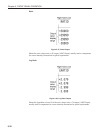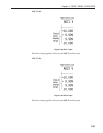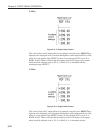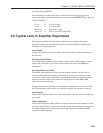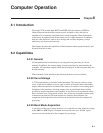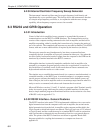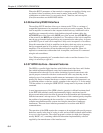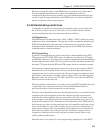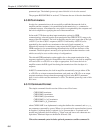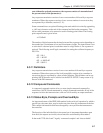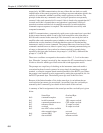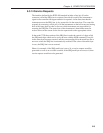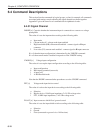
6-3
Chapter 6, COMPUTER OPERATION
The main advantages of the RS232 interface are:
1. It communicates via a serial port which is present as standard equipment on
nearly all computers, using leads and connectors which are available from
suppliers of computer accessories or can be constructed at minimal cost in the
user’s workshop.
2. It requires no more software support than is normally supplied with the computer,
for example Microsoft’s GWBASIC, QBASIC or Windows Terminal mode.
A single RS232 transmission consists of a start bit followed by 7 or 8 data bits, an
optional parity bit, and 1 stop bit. The rate of data transfer depends on the number of
bits per second sent over the interface, usually called the baud rate. In the model 7220
the baud rate can be set to a range of different values up to 19,200, corresponding to
a minimum time of less than 0.5 ms for a single character.
Mostly for historical reasons, there are a very large number of different ways in
which RS232 communications can be implemented. Apart from the baud rate options,
there are choices of data word length (7 or 8 bits), parity check operation (even, odd
or none), and number of stop bits (1 or 2). With the exception of the number of stop
bits, which is fixed at 1, these settings may be adjusted using the three front-panel
RS232 SETUP menus, discussed in chapter 4. They may also be adjusted by means
of the RS command.
In order to achieve satisfactory operation, the RS232 settings must be set to
exactly the same values in the terminal or computer as in the lock-in amplifier.
6.3.03 Choice of Baud Rate
Where the lock-in amplifier is connected to a terminal or to a computer implementing
an echo handshake, the highest available baud rate of 19,200 is normally used if, as is
usually the case, this rate is supported by the terminal or computer. Lower baud rates
may be used in order to achieve compatibility with older equipment or where there is
some special reason for reducing the communication rate.
6.3.04 Choice of Number of Data Bits
The model 7220 lock-in amplifier uses the standard ASCII character set, containing
127 characters represented by 7-bit binary words. If an 8-bit data word is selected,
the most significant bit is set to zero on output from the lock-in amplifier and ignored
on input. The result is that either the 8-bit or the 7-bit option may be used, but the
7-bit option can result in slightly faster communication.
6.3.05 Choice of Parity Check Option
Parity checks are not required at the baud rates available in the model 7220, that is up
to 19,200 baud, with typical cable lengths of up to a few meters. Therefore no
software is provided in the model 7220 for dealing with parity errors. Where long
cables are in use, it may be advisable to make use of a lower baud rate. The result is
that any of the parity check options may be used, but the no-parity option will result
in slightly faster communication.




